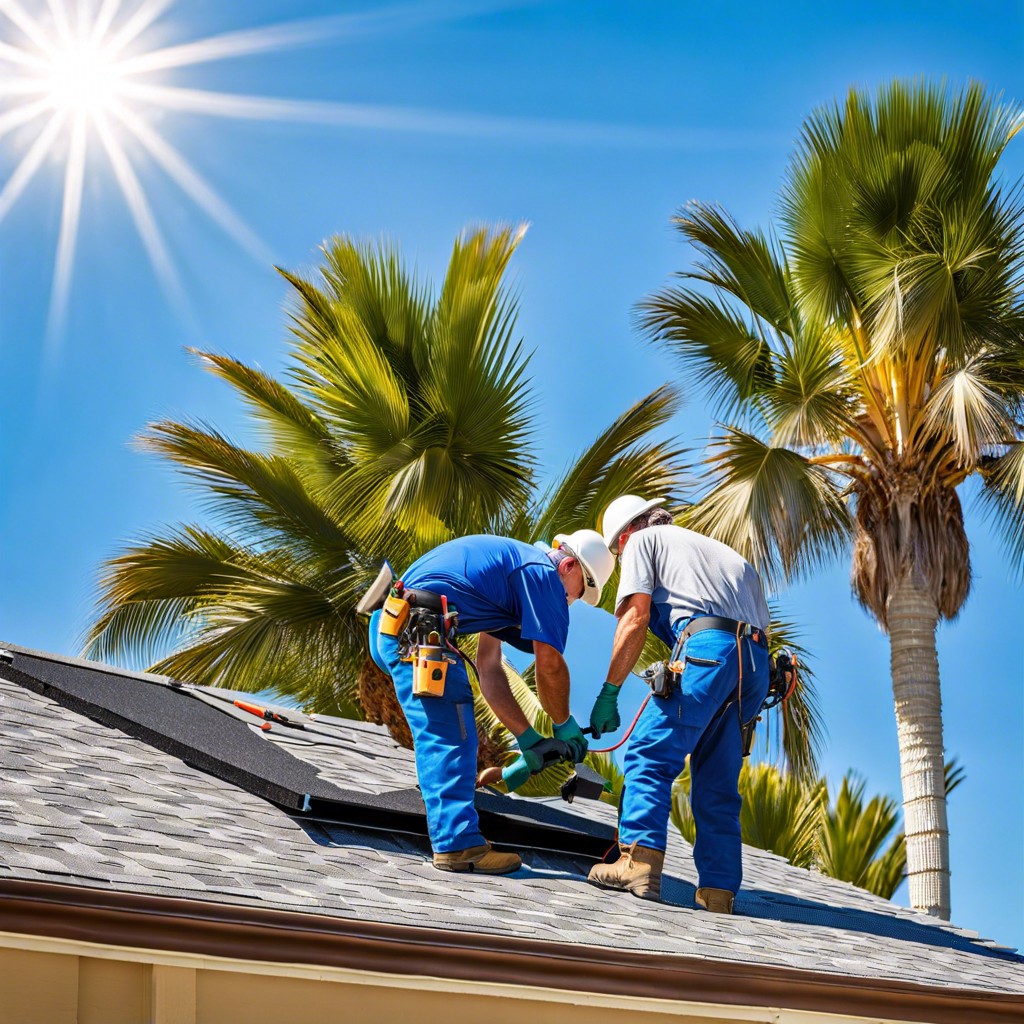Last updated on
This article examines the lifespan of shingle roofs in Florida’s unique climate and what factors influence their durability.
Key takeaways:
- Select High-Quality Materials, Follow Installation Guidelines, Ensure Workmanship
- Florida’s Climate: Heat, Humidity, Algae, Mold, Hurricanes, and Storms
- Regular Maintenance: Clean Debris, Check for Damage and Algae, Maintain Flashing
- Proper Ventilation: Temperature Regulation, Moisture Reduction, Preventing Heat Damage, Energy Efficiency
- Hire a Professional Roofing Contractor: Knowledge, Correct Installation, Enhanced Durability, Warranty
Installation Process

The longevity of a shingle roof in Florida hinges significantly on the quality of its installation. To ensure durability:
- Select High-Quality Materials: Coastal areas require shingles that can withstand salt spray and high winds.
- Follow Manufacturer’s Guidelines: This guarantees that the shingles perform as tested.
- Workmanship: Experienced roofers ensure each shingle is securely fastened and properly aligned, preventing future issues.
- Underlayment and Flashing: Use of a high-grade underlayment and proper flashing installation are crucial barriers against water penetration.
- Sealing and Fastening: Shingles should be adequately sealed and nailed to resist uplift forces from strong winds.
Proper installation lays the groundwork for a roof that can not only reach but potentially exceed its expected lifespan, particularly in Florida’s challenging environment.
Climate and Weather Conditions
Florida’s climate exerts considerable influence on the lifespan of shingle roofs. The state’s notorious heat and humidity can accelerate the deterioration of roofing materials. Sun exposure can cause shingles to become brittle and crack over time, while high humidity levels may promote the growth of algae and mold, which can weaken shingles.
Additionally, Florida is prone to severe weather events such as hurricanes and tropical storms. These events often bring high winds that can tear off shingles or lift them, allowing water to penetrate the roof. Torrential rains can also test the integrity of a roofing system, leading to potential leaks and water damage.
Even outside of extreme weather, the frequent storms typical of Florida’s climate can take a toll on shingle roofs. The cycle of wet and dry conditions may cause shingles to expand and contract, potentially leading to cracking and curling. This can shorten the lifespan of a roof and necessitate more frequent repairs or replacement.
Regular Maintenance
To maximize the lifespan of a shingle roof in Florida, regular maintenance is pivotal. Inspections by homeowners or professionals should occur at least biannually, and following severe weather events.
During these inspections:
- Remove debris from the roof surface, gutters, and downspouts to prevent water pooling and reduce potential mold or algae growth.
- Look for missing, cracked, or curled shingles, which are common signs of wear and suggest that repairs or replacements may be necessary.
- Check for signs of moss or algae, which thrive in Florida’s humid climate and can compromise shingle integrity. Cleaning solutions or zinc strips can mitigate their growth.
- Ensure that flashing around vents, skylights, and chimneys is sealed and intact to prevent water intrusion.
- Trim overhanging tree branches to reduce shade and debris, and to minimize damage from falling limbs.
Prompt attention to small issues can prevent them from escalating, safeguarding the durability of your roof.
Proper Ventilation
Ensuring adequate ventilation is critical to extending the lifespan of a shingle roof in Florida. Effective ventilation systems help regulate attic temperatures and humidity levels, which, if left unchecked, can degrade roofing materials and reduce their lifespan.
Here’s how proper ventilation contributes to roof longevity:
- Temperature Regulation: Attic temperatures can soar in Florida’s heat, causing shingles to deteriorate faster. A ventilated roof allows hot air to escape, reducing the thermal load on the shingles.
- Moisture Reduction: Florida’s humidity can lead to condensation in the attic. Ventilation helps to expel moist air, keeping the roof deck dry and preventing rot.
- Preventing Heat Damage: Continuous venting prevents heat buildup that can cause the underlying roofing materials to age prematurely.
- Energy Efficiency: A well-ventilated roof contributes to lower cooling costs, as less heat accumulates in the attic, reducing the strain on air conditioning systems.
- System Options: Ridge vents, soffit vents, and turbines are examples of ventilation systems that facilitate consistent airflow under the roof.
- Compliance with Building Codes: Adhering to local building codes regarding ventilation can not only extend the roof’s life but also maintain its warranty.
By considering the critical role of proper ventilation, homeowners can protect their shingle roofs against the harsh Florida elements, ultimately achieving a longer-lasting roofing system.
Hire a Professional Roofing Contractor
Selecting a qualified roofing contractor is crucial for maximizing the lifespan of a shingle roof in Florida. Professionals possess the requisite knowledge to choose materials best suited to the state’s unique climate. They ensure correct installation techniques, which is fundamental in preventing premature deterioration.
A contractor’s expertise also extends to identifying optimal roofing systems that offer enhanced durability amid Florida’s frequent high winds and heavy rains. Additionally, established contractors are likely to provide warranties that protect homeowners against defects and improper installation, offering an extra layer of assurance in your roofing investment.
Always verify a contractor’s license, insurance, and references to ensure a high-quality roofing project.




